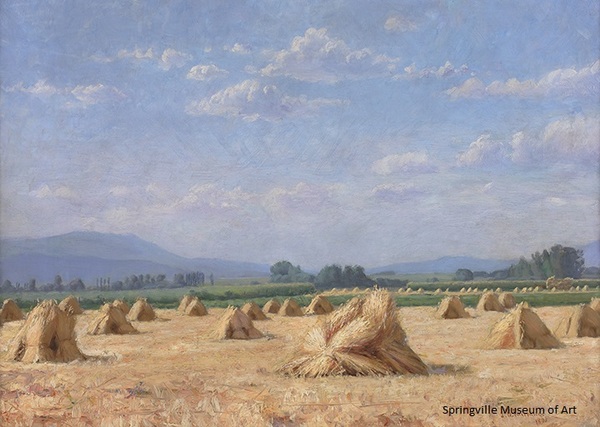Dublin Core
Title
Description
Utah boasts a long history of talented artists. In fact, some of our state’s first settlers studied abroad in the late-nineteenth century academies of France. As LDS Church leaders sought to establish cultural traditions in their new colony, they sent a handful of painters to Paris to learn the techniques of romanticism and impressionism. These students, called “art missionaries,” returned with skills used to paint the interiors of Mormon temples and churches. But some also chose to capture the simplicity of everyday pioneer life in paintings. And a surprising number of them chose to focus on one rural subject specifically: haystacks.
The sun hitting the yellow gold hay – casting shadows and gleaming through the trees – made haystacks an inspiring subject for many French impressionists such as Claude Monet. One art missionary, Edwin Evans, wrote home from Paris that he and his companions were learning about depicting light and the landscape, saying "Utah is noted for her sunlights."
For other artists, haystacks represented something more metaphorical. Art missionary John B. Fairbanks felt anxious about being good enough to paint murals for the temple, saying in one letter that the idea made him “quake and tremble.” In another letter, he confessed that, “my inability stares me in the face.” Fairbanks was his own harshest critic but persevered because of his religious beliefs. In one of his paintings of the Utah countryside, diminutive haystacks are laid out before the awe-inspiring Wasatch Mountains, representing his small, individual shrinking beneath the all-consuming nature of God.
Even today, haystacks and farm scenes are easy to find in the work of Utah artists. Contemporary painter Gary Ernest Smith, for example, is known for his portrayal of rural landscapes and figures of the American West. His depictions capture his roots as a farmer, but also romanticize rural labor in a way that is familiar to us because of the work of the nineteenth-century "art missionaries."
These artists attempted to capture the beauty and mystery of Utah's rural landscape. Haystacks offered a subject through which they could focus on the aesthetic and spiritual qualities of light, faith, and heritage. Imbued with meaning, their work is anything but simple depictions of haystacks.
Creator
Source
_______________
See Emily Larsen, Most Noble Subject: Artists, Muses, and Inspiration in the Miller Wilson Collection(Springville, UT: Springville Museum of Art, 2023); Martha Elizabeth Bradley and Lowell M. Durham Jr., “John Hafen and the Art Missionaries,” Journal of Mormon History 12 (1985), pp. 91-105; William Seifrit, “Letters from Paris,” Utah Historical Quarterly 54, no 2 (1986); Tom Alder, “Purpose and Legacy: The Paris Art Mission of 1890-1892,” Artists of Utah, 15 Bytes, December 13, 2007; James R. Swensen, “The Frontier in Paris: Artists from the American West in the French Capital, 1890-1900,” Transatlantica 2 (2017); Linda Jones Gibbs, Harvesting the Light (Salt Lake City: Museum of Church History and Art, 1987).

